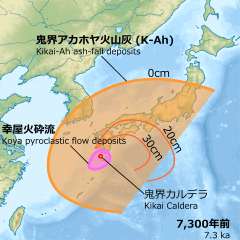Akahoya eruption
The Akahoya eruption was the strongest known volcanic eruption of the Kikai Caldera in Kyūshū, Japan. It ejected about 150 cubic kilometres (36 cu mi) of volcanic material, giving it a '7' on the Volcanic Explosivity Index.[1]
| Akahoya eruption | |
|---|---|
| Volcano | Kikai Caldera |
| Date | 6,500 years ago |
| Type | Ultra-Plinian |
| Location | Kyūshū, Japan 30.789°N 130.308°E |
| VEI | 7 |
| Impact | One of only six eruptions of its size in the Holocene; dramatically changed vegetation in Southern Kyūshū |
 Affected areas of the eruption | |
Retrospective dating
Archaeologically it has been dated around 7,300 cal. BP during the earliest stage of the Jōmon period,[2] but it has also been radiocarbon dated to 6,500 BP.[3]
Aftermath
This eruption has been linked to the end of the initial Jōmon culture in southern Kyūshū. It took nearly 1000 years to recover.[4] However, Jōmon who lived further away survived such as on Honshu and Hokkaido.
This would make the fate of the initial Jōmon culture on south Kyūshū parallel the demise of the Minoan civilization, both ending as a consequence of massive volcanic eruptions.
These events give more credence to cultural traditions that maintain stories of established cultures vanishing quickly and completely, since it is known to have happened at least twice in (Holocene) human history, in two very different parts of the world. The events also call for deeper study into the effects of volcanic activity on human cultural development.
References
- "Eruptive history of Kikai". Global Volcanism Program. Washington, DC: Smithsonian Institution.
- Kuwahata, Mitsuhiro (2002). "Age and cultural influence of the Kikai-Akahoya eruption as seen from archaeological material in south Kyūshū, Japan". Quaternary Research. 41 (4): 317–330. doi:10.4116/jaqua.41.317. ISSN 0418-2642.
- Maeno, Fukashi; Taniguchi, Hiromitsu (2005). "Eruptive history of Satsuma Iwo-jima Island, Kikai caldera, after a 6.5 ka caldera-forming eruption". Bulletin of the Volcanological Society of Japan. 50 (2): 71–85. ISSN 0453-4360.
- "巨大カルデラ噴火のメカニズムとリスクを発表" [Announcement of the mechanism and risks of a massive caldera eruptions] (Press release). Kobe University. 22 October 2014. Archived from the original on 30 March 2019. Retrieved 31 March 2019.